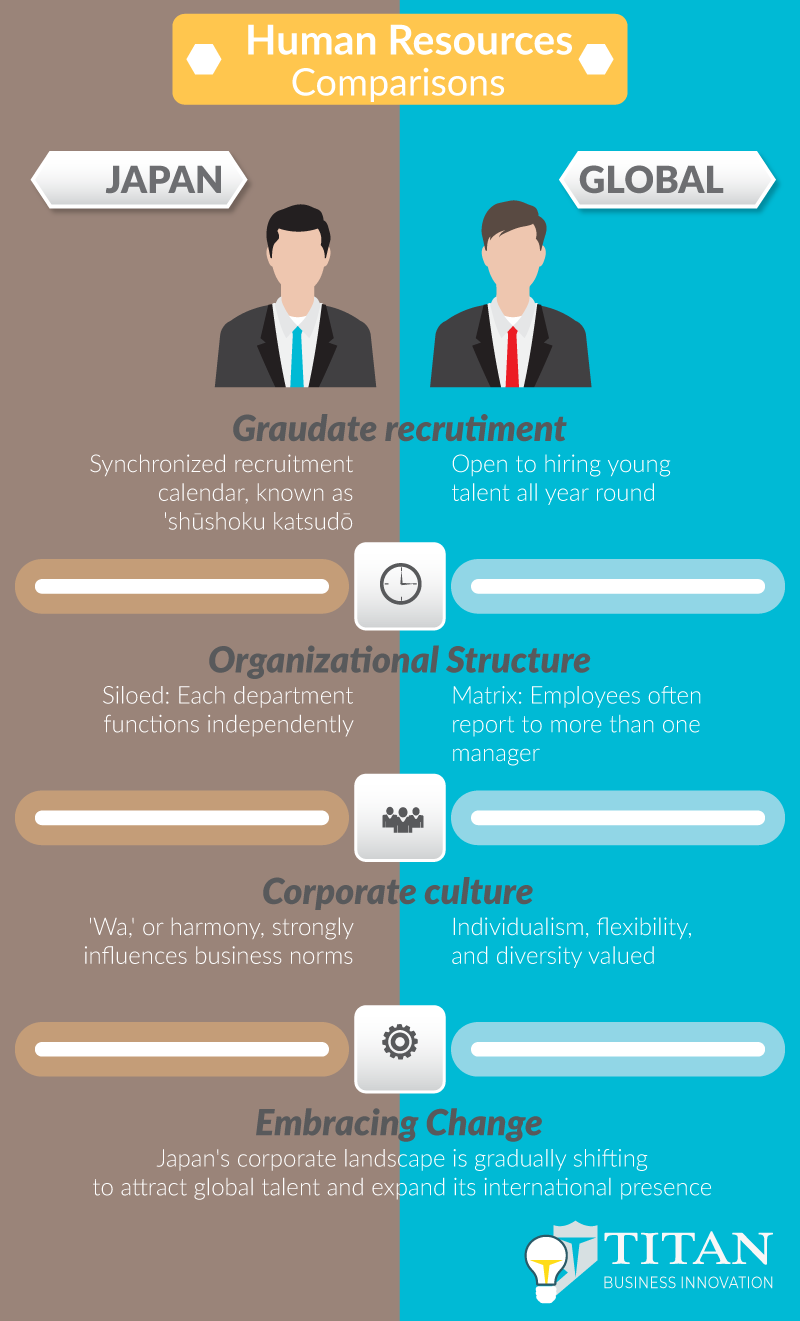Japan’s corporate environment offers a fascinating mix of traditional business norms and international practices. This amalgamation is seen in domestic and global companies’ human resources (HR) strategies, specifically in new graduate programs and organizational structures. This article comprehensively explores these differences, infused with examples and statistics, offering an insightful look at Japan’s unique business culture.
New Graduate Programs: A Study in Contrasts
Japanese domestic companies are known for their regimented approach to new graduate recruitment. These firms traditionally follow a synchronized recruitment calendar, known as ‘shūshoku katsudō,’ which typically starts in the penultimate year of university. A survey by the Japan Institute for Labour Policy and Training in 2021 reported that over 70% of domestic firms adhere to this recruitment timeline.
An example of this traditional approach is Toyota, which hires over a thousand new graduates annually. These hires are typically offered ‘naitei’ (informal job offers) more than a year before graduation, creating a sense of security and loyalty from the onset.
Mitsubishi UFJ Financial Group, one of the largest banking corporations in Japan, follows the traditional Japanese approach to graduate recruitment. They offer an intensive one-year training program for new recruits, instilling the company’s ethos and business knowledge. The program provides broad exposure, fostering loyalty and long-term commitment.
On the contrary, global companies in Japan exhibit more flexibility in their recruitment. These organizations are open to hiring talent all year round and are not restricted to new graduates. For instance, Google Japan reported in 2022 that more than 40% of its new hires were mid-career professionals, highlighting a clear divergence from the traditional graduate recruitment norm. Furthermore, global companies champion diversity, hiring from various backgrounds and experiences, enriching their talent pool.
IBM Japan stands out as a global company with a unique approach. Rather than adhering to the traditional ‘shūshoku katsudō,’ IBM conducts year-round recruitment. They also offer internships and short-term programs to students and professionals, a stark departure from the typical Japanese corporate pathway.
While Japanese companies have expressed a desire to hire non-Japanese and broaden their recruitment base in practice, there are many challenges. These challenges are not only language which is difficult for some non-Japanese to achieve a native level of proficiency. Career expectations can vastly differ between Japanese and non-Japanese, and it can be challenging to match work values.

Organizational Structure: Siloed vs. Matrix
Another distinct difference lies in the organizational structures of domestic and global companies. Japanese companies typically employ a vertical or ‘siloed’ structure, wherein each department functions independently, often leading to information hoarding and a lack of inter-departmental collaboration. According to a 2022 survey by the Ministry of Economy, Trade, and Industry, over 60% of domestic companies in Japan continue to operate under such a structure.
Staff in Japanese companies will often participate in a rotation system where they get experience in many different parts of the organization, for instance, sales, finance, marketing, and production. This produces staff with an excellent general knowledge of the company but needing more specialized skills.
This structure creates excellent loyalty and a team environment in Japanese companies, but it can be challenging for the staff to change companies as external companies want experts, not generalists. Also, staff who transfer to Japanese companies can find it difficult to get promoted, as tenure and internal connections are vital.
Sony, for example, was renowned for its siloed structure, where different product lines were handled by separate departments, leading to minimal cross-department communication. However, in recent years, it has initiated steps to break down these silos, highlighting the growing need for structural evolution in domestic firms.
Japanese domestic airlines like ANA and JAL typically operate under a hierarchical or siloed structure. Each department (e.g., ground crew, cabin crew, engineering, etc.) functions independently, with its own management and reporting system. This structure is deeply ingrained in their operations but can result in slower decision-making processes and limited cross-departmental cooperation.
On the other hand, global companies in Japan usually adopt a matrix structure, where employees often report to more than one manager. This structure encourages cross-departmental collaboration and knowledge sharing. For example, Procter & Gamble Japan has effectively used a matrix structure to foster teamwork and accelerate decision-making processes.
Global consulting firms like McKinsey & Company, operating in Japan, utilize a matrix structure that encourages teamwork and communication across various functions and levels of the organization. For instance, a McKinsey consultant may report to a project manager for a specific client assignment and a department head for their functional expertise. This structure maximizes resources, fosters collaboration, and accelerates decision-making.

Cultural Underpinnings: The Harmony of Society and Business
The root of these differences lies in the cultural fabric of Japan. The Japanese principle of ‘Wa,’ or harmony, strongly influences business norms in domestic companies, promoting unity and stability. This can be seen in their recruitment practices and siloed structures, fostering a sense of group identity and commitment.
Conversely, global companies in Japan, often influenced by Western corporate culture, value individualism, flexibility, and diversity. These values manifest in their dynamic recruitment practices and collaborative matrix structures.
One difference is the speed of decision-making between Japanese and Global companies. Due to the desire for many people to be part of the decision-making process, Japanese companies can take longer than their overseas counterparts. This approach can reduce the risk of mistakes and foster a strong company connection, whereas Global companies rely more on internal experts to make faster decisions.
The Middle Path: Embracing Change
With globalization permeating every business facet, Japan’s corporate landscape is gradually shifting. Rakuten, a Japanese electronic commerce and online retailing company, has been a notable exception in the Japanese corporate landscape. It moved to English as the company’s official language in 2012 to attract global talent and expand its international presence. They’ve also adopted a more open and flexible recruitment approach, paralleling the practices of multinational companies.
Domestic firms like Fast Retailing have started to adapt by making English their official corporate language and diversifying their recruitment practices. Similarly, global companies like Amazon Japan have begun participating in the traditional new graduate hiring process to integrate more seamlessly into the local corporate culture.
One big opportunity for Japanese staff with a command of English working in domestic companies is the opportunity to transfer to overseas departments. There still needs to be more English-speaking Japanese staff who can effectively communicate in international business environments.
While primarily operating under the global practices of its parent company, Google Japan has shown efforts to accommodate Japanese traditions. Recognizing the cultural significance of ‘shūshoku katsudō,’ Google has started participating in job fairs and recruitment events for new graduates. It has also introduced benefits like ‘workation’ (working vacation) to respect the Japanese appreciation for work-life balance.
In this dynamic environment, the contrasts between domestic and global companies’ HR strategies in Japan present a captivating mosaic. These differences, rooted in cultural values and business principles, shape the unique character of Japan’s corporate world. As businesses continue to adapt and evolve, it will be intriguing to witness the transformation of HR practices in the face of an increasingly globalized world.

